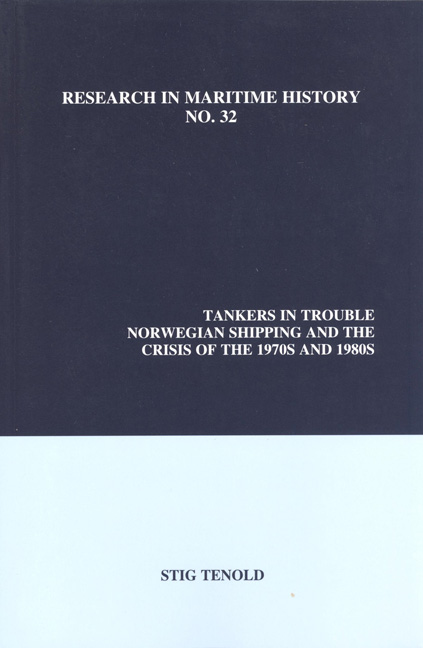Book contents
- Frontmatter
- Table of Contents
- List of Tables in the Text
- List of Illustrations
- Preface
- Chapter 1 Introduction
- Chapter 2 The Shipping Market after World War II
- Chapter 3 The Basis of the Tanker Crisis
- Chapter 4 The Contagion and Short-term Effects of the Crisis
- Chapter 5 Stage Two of the Crisis and the Long-term Changes
- Chapter 6 The Basis for the Crisis in Norwegian Shipping
- Chapter 7 Structural Transformations in Norwegian Shipping
- Chapter 8 The Fates of Four Norwegian Shipowners
- Chapter 9 Conclusion
- Appendices
- Bibliography: Select Bibliography
Chapter 9 - Conclusion
- Frontmatter
- Table of Contents
- List of Tables in the Text
- List of Illustrations
- Preface
- Chapter 1 Introduction
- Chapter 2 The Shipping Market after World War II
- Chapter 3 The Basis of the Tanker Crisis
- Chapter 4 The Contagion and Short-term Effects of the Crisis
- Chapter 5 Stage Two of the Crisis and the Long-term Changes
- Chapter 6 The Basis for the Crisis in Norwegian Shipping
- Chapter 7 Structural Transformations in Norwegian Shipping
- Chapter 8 The Fates of Four Norwegian Shipowners
- Chapter 9 Conclusion
- Appendices
- Bibliography: Select Bibliography
Summary
The crisis of the 1970s and 1980s fundamentally changed the shipping market. A large number of companies were forced to lay-up their vessels; the relationship with creditors became increasingly problematic; and profits diminished. For many, the result was liquidation or bankruptcy. The shipbuilding industry found it ever more difficult to attract new orders. Although subsidies provided a temporary reprieve, from the late 1970s onwards the industry was downscaled and lost its historic position, especially in Western Europe. Several traditional maritime nations were unable to adapt to the new conditions and suffered from a massive disinvestment in shipping.
This book has had two aims. The first was to analyse the causes and effects of the most serious shipping crisis of the twentieth century. The second was to explain why Norwegian shipowners were more severely affected than their foreign competitors, and to trace the effects of the crisis on the Norwegian shipping sector.
The situation in the early 1970s represented a dramatic break with the first postwar decades. When this “golden age” ended, most sectors had to readjust from rapid expansion to lower growth. But the transformation in shipping was more extensive than for many other sectors. There were a number of reasons for this. The pre-crisis development had been particularly positive, while the crisis was both more severe and prolonged than in other sectors. Moreover, the shipping industry cannot “smooth” demand fluctuations by producing for stock. After 1974 demand dwindled while the fleet increased, resulting in a severe imbalance. In the first part of the 1980s an absolute reduction in oil transport aggravated the already difficult state of the market.
On the demand side, two developments were particularly important. First, the oil price increases initiated by the Organisation of Petroleum Exporting Countries transferred the status of oil from a source of energy to an instrument of economic and political warfare. Oil transports - the driving force behind shipping expansion in the 1950s and 1960s - could no longer be counted upon to produce annual two-digit growth rates. Second, the world economy underwent a transition from high growth to recession and limited trade expansion. Reduced activity affected trade and transport demand for some of the most important bulk commodities.
- Type
- Chapter
- Information
- Tankers in TroubleNorwegian Shipping and the Crisis of the 1970s and 1980s, pp. 221 - 228Publisher: Liverpool University PressPrint publication year: 2006

